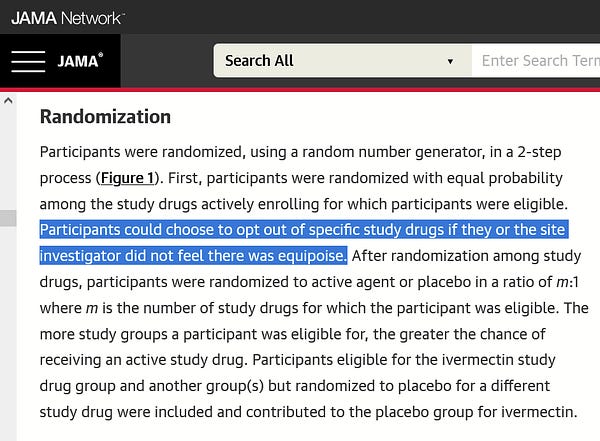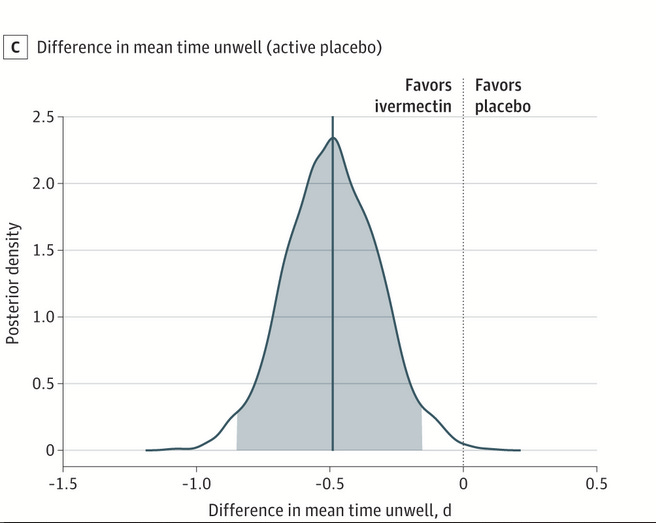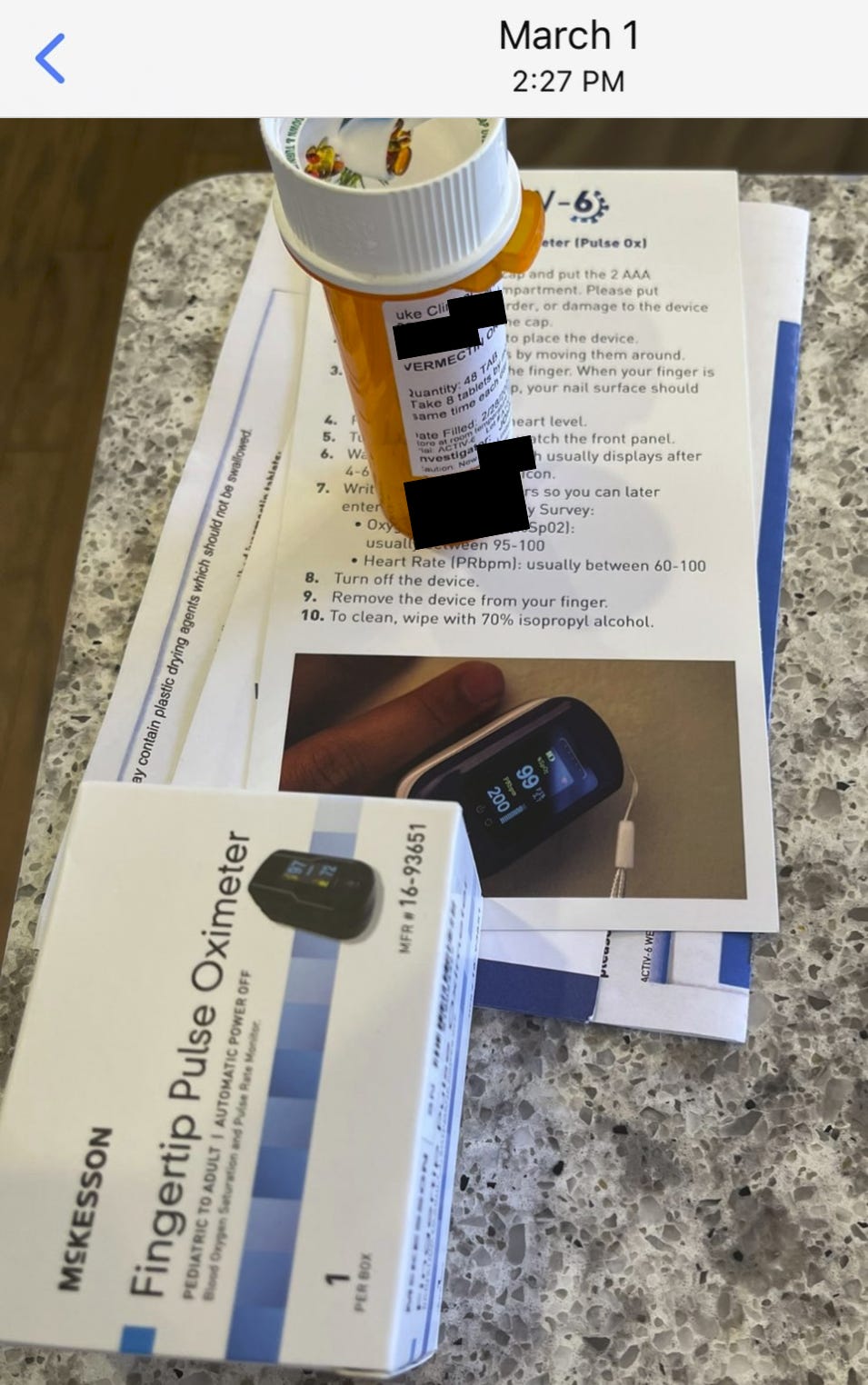This could only have happened in the era of Twitter: when I posted my previous article on the ACTIV-6 trial on ivermectin, I came in contact with a participant from the ACTIV-6 trial. You heard that right. The contents of this article are coming… straight from the horse’s mouth.
The ACTIV-6 patient confirmed much of what we suspected about the trial:
The participant contacted the trial staff within 5 days after symptoms started. They were enrolled in the trial 7 days after initial symptoms. Official “day 1” in the trial was 10 days after symptom onset. The medicine arrived a full 11 days after symptoms started.
The patients were taken at their word that they had a positive test; a self-administered rapid antigen test was sufficient.
Most patients never saw the trial staff, and didn’t speak to them on the phone after the first few days.
Patients were asked which drug they preferred to randomize for, opening real questions with regard to the validity of the randomization process.
A $100 Amazon gift card was used as inducement to complete all the forms in the trial. (This was not advertised before signing up for the trial.)
The patient in this case participated in the ACTIV-6 600 arm—whose recruitment is completed but results have not yet been published—and is part of the same overall trial as the recently published ACTIV-6 400 study.
I won’t reveal the patient’s name, as they have requested confidentiality, but they’ve provided proof that they were, in fact, part of the trial. This photo is of the trial instructions and the medicine bottle they received:
They’ve also shared much of their communication from the trial—including the initial email linking to the consent form:
Timeline
From the patient’s descriptions, I have assembled the following timeline, which they have reviewed and confirmed as correct:
Feb 17, 2022 (Thursday) - Felt tired p.m.
Feb 18, 2022 (Friday) - Woke up feeling fine, by that afternoon had a cough and tickle in throat. (Later defined as first day of symptoms.)
Feb 19, 2022 (Saturday) - Woke up feeling worse than day prior. By dinner was in bed and feverish.
Feb 20, 2022 (Sunday) - Was the worst day. Bed ridden with fever and body aches.
Feb 21. 2022 (Monday) - Took a RAT [ed: rapid antigen test] out of curiosity. It indicated positive almost instantly. I think I actually just Googled “Ivermectin COVID-19 trials” when I tested positive.
Feb 22, 2022 (Tuesday) - Nothing.
Feb 23, 2022 (Wednesday) - Signed up online to be contacted. I specified IVM.
Feb 24, 2022 (Thursday) - Received consent documentation. I spoke with the trial people for screening. They asked if I had a preference between IVM and fluvoxamine, I said I preferred IVM. Was enrolled into that after answering some questions about basic health and any other medications I may be taking. Incidentally lost sense of smell on same day, but fever and aches were gone. Cough was improving.
Feb 25, 2022 (Friday) - Got enrollment questionnaire.
Feb 26, 2022 (Saturday) - Nothing.
Feb 27, 2022 (Sunday) - Nothing.
Feb 28, 2022 (Monday) - First daily check-in. Medicine filled & shipped.
Mar 1, 2022 (Tuesday) - Meds arrived. Daily check-in.
Mar 13, 2022 (Sunday) - Last daily check-in.
Mar 28, 2022 (Monday) - Last weekly check-in.
May 29, 2022 (Sunday) - Last long-term check-in.
Analysis
Timing
The patient first reached out to the trial on the 23rd of February. It took a whole six days to get the medication to them. It is well known and understood that antivirals must be given early in the course of treatment. For instance, this is what the package insert for Paxlovid says:
We already know that 75% of the patients in the ACTIV-6 400 trial would not have qualified for the Paxlovid trial—given that they entered the trial after more than five days of symptoms.
What we learned from this testimony is that this was entirely avoidable had the organizers completed all the various enrollment steps within one day and made sure to have had staff working over the weekend, which I assume is the reason there was no progress over the Saturday and Sunday (Feb 26 & 27). The virus does not take days off.
Worse, the medications were shipped on day 1 of being admitted to the trial, meaning the results should be understood to include (at least) one day for shipping after day 1 of the trial. (And that’s before we even consider possible delivery delays.)
Delivery Issues
The authors report in the ACTIV-6 400 trial report that of the 1800 patients randomized, 209 did not receive their medication and were therefore excluded. Given that we now know these patients were randomized before the medicine was shipped, we should at least be shown their baseline characteristics to see if there was a systematic difference between included and excluded patients. (For instance, it could be that rural patients had more difficulties receiving their medication.) We also don’t know if certain areas had more shipment delays. The patient reported that their medication was shipped from Arizona to North Carolina. What are the implications for patients in Hawaii or Alaska, or New York City, where package theft is common?
Randomization
When I first read the ACTIV-6 paper, learning that they’d given patients a choice of drug struck me as a surprising feature:


Let me explain what I meant, which this patient’s testimony confirms. From the paper, we see that 229 of the 774 placebo patients were randomized to a placebo matching a different active agent:
This means that, besides the various issues related to taking different placebo regimens (e.g. fluticasone is given via an inhaler, not a pill), we have a systematic difference between placebo and treatment populations. If the patient’s testimony is typical—and we have no reason to assume otherwise—the 817 treatment patients actively opted into ivermectin. However, when it comes to the placebo patients, it includes patients that either opted out of ivermectin or explicitly opted into another drug.
Ivermectin has been politicized in the US (due in no small part to the messaging coming out of high-profile NIH employees such as Dr. Anthony Fauci). This means we should expect the demographic differences between political groups to be reflected, in part, in the patients who opted in or out of ivermectin. This gives us a legitimate reason to be concerned about the quality of randomization in this trial: the groups are not drawn from identical patient populations.
Potential For Participation Fraud
While the $100 Amazon gift card tried to solve a real problem with patients in remote trials not completing their followup forms, it opens up an issue of participation fraud. Even though the perk was not advertised before signup, consider the following event sequence: Patient X takes part in the study and gets a $100 gift card. Patient X then tells Patient Y that they could sign up for the trial, pretend to be ill, fill in the various forms, and get a $100 gift card at the end. There exist people for whom this scam would be a worthwhile use of time. It would be good to know what—if anything—the trial organizers did to filter out such cases.
Conclusion
I empathize with the complexities of organizing a trial like this. However, the organizers simply cannot represent it as a well-run trial—whose results are informative as to the value of ivermectin and other repurposed drugs—without first understanding the various factors involved.
I have previously used the “FM radio receiver” metaphor to describe how I interpret clinical trial results. If a radio receiver is not precisely set to the right frequency—and the distance from the broadcast antenna is too far—there is all sorts of interference from other nearby radio stations. We can still hear the radio station we want to tune into—faintly—so this cannot be treated as evidence against the station’s existence, but the signal cannot be called strong.
This is what I see in this trial. All sorts of things could have been done better. And yet, ivermectin showed a real signal, with some endpoints even meeting the authors’ definition of “significance”:


Still, different endpoints were selected to be emphasized. I hope the results of the ACTIV6-600 trial—which are yet to be reported—are approached with a more even hand.
This drug keeps failing to fail, and historians won’t have a hard time putting two and two together.
I’d like to thank the source of this story for coming forward and giving us a unique look behind the scenes. This is the kind of information we’ve been missing so far, and these insights help us complete the puzzle of exactly what went on in these trials. If for nothing else, then at the very least for preservation in the historical record.
If anyone else has a similar story from a clinical trial, please get in touch over DM on Twitter.







Thank you Alexandros for your relentless sleuthing. For me, this is the article that reveals the smoking gun. Finally it all falls into place, finally the outcomes of this trial make perfect sense.
So given after 6 (11?) days, ivermectin for COVID19 seems about as effective as Tamiflu given within 48 hours for influenza. One drug is widely panned while the other is widely prescribed.